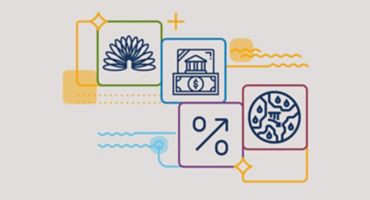- Fixed Income Portfolio Manager
Skip to main content
- Funds
- Insights
- Capabilities
- About Us
- My Account
The views expressed are those of the author at the time of writing. Other teams may hold different views and make different investment decisions. The value of your investment may become worth more or less than at the time of original investment. While any third-party data used is considered reliable, its accuracy is not guaranteed. For professional, institutional, or accredited investors only.
In a unanimous decision across members, the Federal Open Market Committee (FOMC) hiked its target interest rate by 25 basis points (bps), to a range of 4.75% to 5.00%, at its March 2023 meeting. Some market participants had expected (and wanted) the US Federal Reserve (Fed) to instead pause its policy-tightening campaign given the current state of the US banking sector, emphasizing a perceived need to prioritize systemic financial stability over the Fed’s ongoing battle to contain inflation.
The recent banking sector stresses — highlighted by some high-profile bank failures and a wave of deposit outflows from others — are likely to lead to tighter lending standards and overall financial conditions going forward, which should eventually help ease persistent US inflationary pressures. While the Fed’s post-meeting statement tried to assure listeners that “the US banking system is sound and resilient,” it also acknowledged the potentially adverse impact that the events of the past couple of weeks could have on economic growth and inflation.
Meanwhile, in Europe, the acquisition of beleaguered Credit Suisse (CS) by UBS, which was arranged by Swiss regulators, proved that the challenges facing many banks are not unique to the US and prompted coordinated actions by global central banks.
In its updated Summary of Economic Projections (SEP), the Fed projected one more rate hike this year, slightly increased its 2023 inflation forecasts, and upped its policy rate estimate for 2024 to 4.3% (from 4.1% in December 2022). The annual US headline and core inflation rates, as measured by the Consumer Price Index (CPI), held steady at 6.0% and 5.5%, respectively, year over year in February 2023.
Most of the leading economic indicators I track now suggest that US house prices (and shelter costs broadly) will decline more meaningfully over the next six to 12 months than previously thought, as the lagged effects of higher Fed policy rates kick in. Continued US labor market strength bolstered the Fed’s case for its latest rate hike: The unemployment rate ended February at just 3.6%, although many of the recently announced layoffs in sectors such as technology have not yet been reflected in US employment figures.
The Fed retained the caps on its monthly reduction of US Treasuries and agency mortgage-backed securities (MBS) at US$60 billion and US$35 billion, respectively. However, the Fed’s balance sheet is still likely to swell this month in the wake of the US bank failures, which led the Fed to launch a new Bank Term Funding Program (BTFP) that provides much-needed loans (and thus liquidity) to depository institutions. Under this program, rather than being forced to sell “high-quality” US Treasuries and agency securities that have lost significant value due to sharply rising rates, banks and other depository institutions can instead pledge these securities (at par value) as collateral for loans.
In addition to the BTFP, discount window lending now available to existing banks, along with FDIC-backed loans to the new “bridge” entity holding Silicon Valley Bank’s assets, have also increased the size of the Fed’s balance sheet in recent weeks. The combined lending programs will thus effectively unwind the impact of the quantitative tightening program that the Fed has been pursuing since last year (albeit by substituting longer-term for shorter-term holdings, which I think will have less influence on risk asset pricing).
As of this writing, I suspect the Fed may have just reached its terminal policy rate and will likely keep rates “on hold” for the foreseeable future in order to assess whether monetary policy remains restrictive enough to keep pushing inflation lower without tipping the US economy into recession.
In my judgment, the one-two punch of tightening financial conditions, delivered via higher Fed policy rates, and a more restrictive lending environment, should be sufficient to slow US inflation and payroll gains in the coming quarters. I think the Fed will still be reluctant to ease monetary policy ahead of confirmation that both inflation and the labor market are cooling materially. That being said, the Fed’s calculus on that front has clearly changed somewhat over the past few weeks.
Bottom line: The Fed’s delicate balancing act between maintaining financial stability on the one hand, and tamping inflation down to its target level on the other hand, has become even trickier now.
Expert

How to nurture a growth mindset in a higher-yielding landscape
Continue readingState of the credit markets: Does cash rule everything around us?
Continue readingURL References
Related Insights
Stay up to date with the latest market insights and our point of view.

How to nurture a growth mindset in a higher-yielding landscape
In a higher-yield world, can fixed income deliver meaningful growth? John Mullins, Supriya Menon and Alex King explore how high-yield bonds may offer a powerful opportunity for growth - as well as a cushion against uncertainty.
The shifting liquidity landscape: What’s at stake?
The beginning of the end could be in sight for the Federal Reserve’s quantitative tightening (QT) program. US Macro Strategist Juhi Dhawan considers the Fed's next steps and what they could mean for banks, liquidity, and markets broadly.

US regional banking sector update
We explore how banking regulation and legislation could impact US regional banks, including highlighting the potential for M&A activity and for dispersion to drive long/short opportunities.

Financials amid rising dispersion
We explore why we believe dispersion across stocks, sectors, and geographies is supporting numerous secular themes in long/short investing in financials.
State of the credit markets: Does cash rule everything around us?
Fixed Income Portfolio Manager Brij Khurana outlines the state of the credit market today, compares historical periods of quantitative easing, and warns credit investors of cash scarcity in the near future.
FX outlook: Is USD exceptionalism withering away with the Fed hiking cycle nearing an end?
Discover the status of the USD today, learn where the greenback may be headed going forward, and understand why.

Private credit in a new regime
We explore how a shifting macro backdrop, ongoing banking crisis, and evolving competitive dynamics may create opportunities across private credit markets.

Inflation loosens its grip, but bank turmoil could put the squeeze on US growth
US Macro Strategist Juhi Dhawan weighs the benefits of disinflation for consumers and companies against the risks of a credit crunch brought on by the recent bank crisis.

Global high yield: Attractive entry points could soon emerge
Fixed Income Portfolio Manager Konstantin Leidman shares his outlook for high-yield fixed income for the rest of this year and beyond.

Credit market outlook: Expect greater opportunities in back half of 2023
Against a backdrop of elevated recession risks and banking-sector stress, Fixed Income Portfolio Manager Rob Burn identifies relative-value sector opportunities in the credit market.
Did the Fed just make a policy error?
Did the Fed just make a policy error? All things considered, Fixed Income Portfolio Manager Jeremy Forster thinks the answer is yes. Learn why and what the implications could be.
URL References
Related Insights